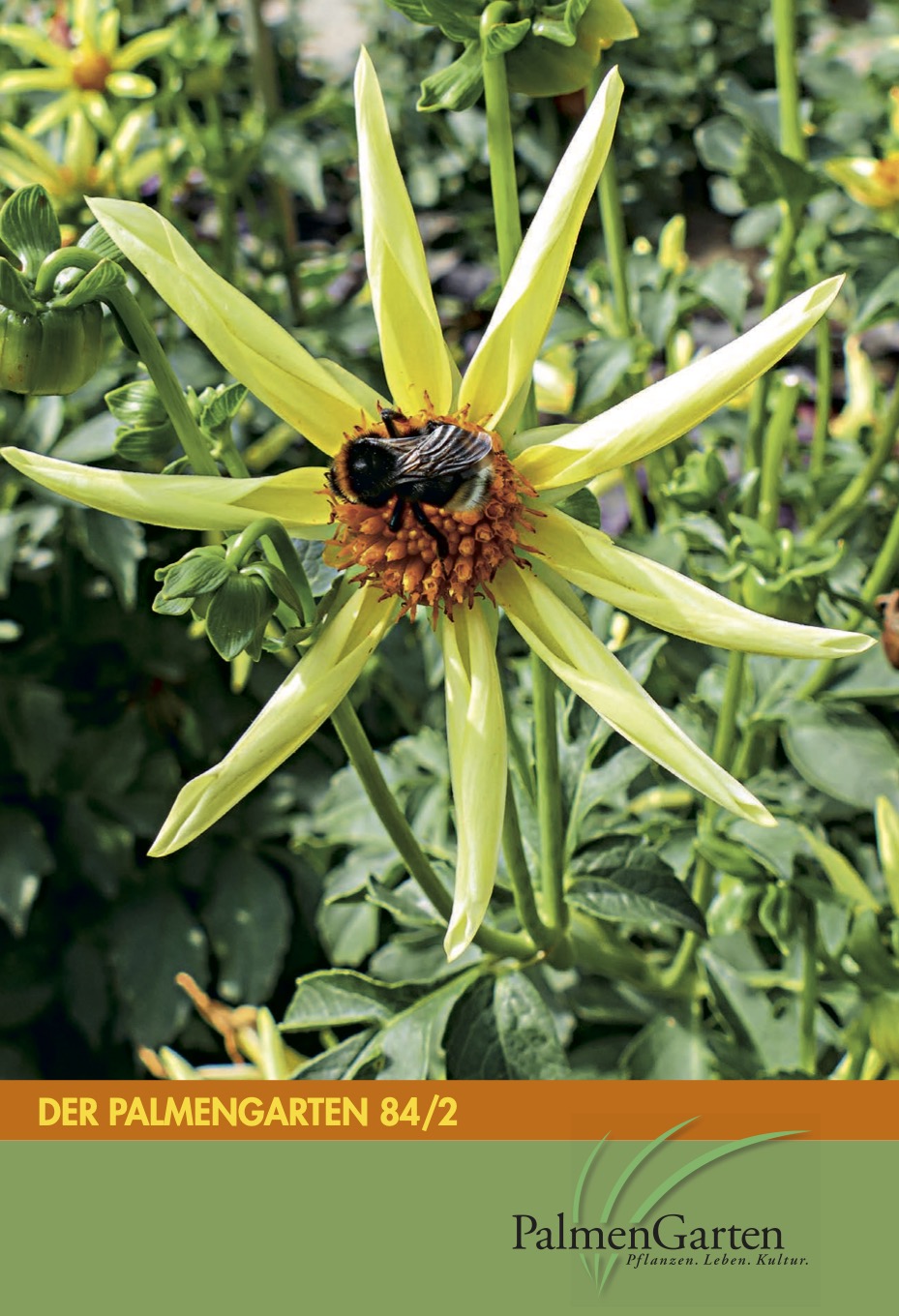Die großen wissenschaftlichen Leistungen von Stefan Vogel (1925–2015) Teil 6 (Schluss). Die Pilzmückenblumen
DOI:
https://doi.org/10.21248/palmengarten.547Abstract
Nachdem Stefan Vogel in den späten 1950er-Jahren bewiesen hatte, dass bei den Kesselfallenblumen von Ceropegia (Apocynaceae-Asclepiadoideae) winzige Fliegen als Bestäuber agieren (Mikromyiophilie), konnte er zwanzig Jahre später eine weitere und ganz spezielle Fliegengruppe als Bestäuber ausmachen: Pilzmücken (Mycetophilidae, Sciaridae u.a.). Vogel konnte weiter zeigen, dass manche Blüten oder Blütenstände im Laufe der Evolution gestaltliche und olfaktorische Merkmale von Pilzen angenommen haben. Solche „Pilzmimeten“ haben sich in mindestens vier Verwandtschaftskreisen entwickelt: Aristolochiaceae (Osterluzeigewächse), Araceae (Aronstabgewächse), Corsiaceae und Orchideen. Als die vielleicht spektakulärsten Fälle sind zu nennen: Aristolochia arborea, mit einer vor dem Eingang der Kesselfalle stehenden Hutpilz-Attrappe, und die Arten der Gattung Dracula (Orchidaceae), deren Labellum den Hut eines Lamellen- oder Leistenpilzes imitiert.
Literaturhinweise
Arcangeli, G. 1891: Sull‘ Arisarum proboscideum Savi.– Nuov. Giorn. Bot. Ital. 23: 545–549.
Endara, L, Grimaldi, D. A. & Roy, B. A. 2010: Lord of the flies: pollination of Dracula orchids.– Lankesteriana 10: 1–11. https://doi.org/10.15517/lank.v10i1.18318
Kaiser, R. 2006: Flowers and fungi use scents to mimic each other.– Science 311: 806–807. https://doi.org/10.1126/science.1119499
Lehnebach, C. A. 2016: New combinations and a replacement name for three New Zealand spider orchids (Corybas).– New Zealand Native Orchid J. 139: 4–5.
Lehnebach, C. & Zeller, A. 2015: Dissecting the smell of deception; the chemistry behind the pollination system of New Zealand spider orchids.– Orchids: 65–70.
Lehnebach, C. A. & Zeller, A. J., Frericks, J. & Ritchie, P. 2016: Five new species of Corybas (Diurideae, Orchidaceae) endemic to New Zealand and phylogeny of the Nematoceras clade.– Phytotaxa 270: 1–24. https://doi.org/10.11646/phytotaxa.270.1.1
Lopes, A. V., Vogel, S. & Machado, I. C. 2002: Secretory trichomes, a substitute floral nectar source in Lundia A.DC. (Bignoniaceae), a genus lacking a functional disc.– Ann. Bot. 90: 169–174. https://doi.org/10.1093/aob/mcf169
Lu, K. L. 1982: Pollination biology of Asarum caudatum (Aristolochiaceae) in northern California.– Syst. Bot. 7:150-157. https://doi.org/10.2307/2418323
Luer, C. A. 1978: Dracula, a new genus in the Pleurothallidinae.– Selbyana 2: 190–198.
Policha, T., Davis, A., Barnada, M., Dentinger, B. T. M., Raguso, R. A. & Roy, B. A. 2016: Disentangling visual and olfactory signals in mushroom-mimicking Draculaorchids using realistic three-dimensional printed flowers– visual and olfactory signals.– New Phytol. 210: 1058–1071. https://doi.org/10.1111/nph.13855
Reiter, N., Freestone, M., Brown, G. & Peakall, R. 2019. Pollination by sexual deception of fungus gnats (Keroplatidae and Mycetophilidae) in two clades of Pterostylis (Orchidaceae).– Bot. J. Linn. Soc. 190: 101–116. https://doi.org/10.1093/botlinnean/boz009
Vogel, S. 1954: Blütenbiologische Typen als Elemente der Sippengliederung, dargestellt anhand der Flora Südafrikas.– Bot. Studien, Heft l, 1–338. Jena: Fischer.
Vogel, S. 1961: Die Bestäubung der Kesselfallenblumen von Ceropegia.– Beitr. Biol. Pflanzen 36: 159–237.
Vogel, S. 1965: Kesselfallenblumen.– Umschau Wiss. & Technik 65: 12–17.
Vogel, S. 1978a: Pilzmückenblumen als Pilzmimeten.– Flora 167: 329–366. https://doi.org/10.1016/s0367-2530(17)31124-6
Vogel, S. 1978b: Pilzmückenblumen als Pilzmimeten. Fortsetzung und Schluß.– Flora 167: 367–398. https://doi.org/10.1016/s0367-2530(17)31130-1
Vogel, S. 1978c: Evolutionary shifts from reward to deception in pollen flowers. In: Richards, A. J. (ed.): The pollination of flowers by insects.– Linn. Soc. Sympos. Series 6: 89–96.
Vogel, S. 1981: Trichomatische Blütennektarien bei Cucurbitaceen.– Beitr. Biol. Pflanzen 55: 325–353
Vogel, S. 1997: Remarkable nectaries: structure, ecology, organophyletic perspectives. I Substitutive nectaries.– Flora 192: 305–333. https://doi.org/10.1016/s0367-2530(17)30798-3
Vogel, S. 1998a: Remarkable nectaries: structure, ecology, organophyletic perspectives. II. Nectarioles.– Flora 193: 1–29. https://doi.org/10.1016/s0367-2530(17)30812-5
Vogel, S. 1998b: Remarkable nectaries: structure, ecology, organophyletic perspectives. III. Nectar ducts.– Flora 193: 113–131. https://doi.org/10.1016/s0367-2530(17)30827-7
Vogel, S. 1998c: Remarkable nectaries: structure, ecology, organophyletic perspectives. IV. Miscellaneous cases.– Flora 193: 225–248. https://doi.org/10.1016/s0367-2530(17)30844-7
Vogel, S. 1999: Die Funktionstypen der Kesselfallenblumen.– 12. Jahrestagung der Gesellschaft für Tropenökologie (gtö), 17-19 Feb. 1999, Ulm (D), Tagungsband (Abstracts), Plenarvortrag V-1.1, p. 20.
Vogel, S. 2000: The floral nectaries of Malvaceae sensu lato: a conspectus.– Kurtziana 28: 155–171.
Vogel, S. 2002: Flickering bodies: Floral attraction by movement.– Beitr. Biol. Pflanzen 72: 89–154.
Vogel, S. 2004a: Contributions to the functional anatomy and biology of Nelumbo nucifera (Nelumbonaceae). I. Pathways of air circulation.– Plant Syst. Evol. 249: 9–25. https://doi.org/10.1007/s00606-004-0201-8
Vogel, S. 2004b: Contributions to the functional anatomy and biology of Nelumbo nucifera (Nelumbonaceae). II. Unique emergent druses on the floral receptacle.– Plant Syst. Evol. 249: 27–35. https://doi.org/10.1007/s00606-004-0202-7
Vogel, S. 2015. Vertebrate pollination in Compositae: floral syndromes and field observations.– Stapfia:reports 103: 5–26.
Vogel, S. & Hadacek, F. 2004: Contributions to the functional anatomy and biology of Nelumbo nucifera (Nelumbonaceae). III. An ecological reappraisal of floral organs.– Plant Syst. Evol. 249: 173–189. https://doi.org/10.1007/s00606-004-0203-6
Vogel, S. & Martens, J. 2000: A survey of the function of the lethal kettle traps of Arisaema (Araceae), with records of pollinating fungus gnats from Nepal.– Bot. J. Linn. Soc. (London) 133: 61–100. https://doi.org/10.1111/j.1095-8339.2000.tb01537.x
Vogel, S. & Müller-Doblies, U. 2011: Desert geophytes under dew and fog: the “curly-whirlies” of Namaqualand (South Africa).– Flora 206: 3–31. https://doi.org/10.1016/j.flora.2010.01.006
Weber, A. 2016: In memorian Stefan Vogel (1925-2015).– Flora 218: 92–93.
Weber, A. & Sonntag, S. 2006: Stefan Vogel 80 years– a life devoted to floral ecology.– Flora 201: 331–339. https://doi.org/10.1016/j.flora.2006.03.001
Weber, A. & Steinecke, H. 2017: Die großen wissenschaftlichen Leistungen von Stefan Vogel (1925–2015): Teil 3. Blütendüfte und ihre Bildung in den Osmophoren.– Palmengarten 81: 69–77. https://doi.org/10.21248/palmengarten.318
Weber, A. & Vogel, S. 1986: The pollination syndrome of Deplanchea tetraphylla (Bignoniaceae).– Plant Syst. Evol. 154: 237–250. https://doi.org/10.1007/bf00990126
Internetseiten
https://www.sciencedirect.com/science/article/pii/S0367253017311246 (Artikel Vogel 1978a; kostenpflichtig)
https://www.sciencedirect.com/science/article/pii/S0367253017311301 (Artikel Vogel 1978b; kostenpflichtig)
http://www.online-keys.net/sciaroidea/add01/Vogel_&_Martens_2000_Pollination.pdf (Artikel Vogel & Martens 2000).
https://www.rnz.co.nz/national/programmes/ourchangingworld/audio/201825731/when-orchids-smell-like-mushrooms-a-tale-of-botanical-deceit (Pilzmückenbestäubte Orchideen Neuseelands)
https://image.dhgate.com/0x0/f2/albu/g4/M01/2B/18/rBVaEVnovmWAFCGSAAMqkVD2wak624.jpg,
http://morzsafarm.hu/wp-content/uploads/2017/09/ ezekneka-viragoknak-tenyleg-arcuk-van-majomkepu-orcidea.jpg (Fotos verschiedener Dracula-Arten)
https://www.sciencedirect.com/science/article/abs/pii/ S036725300600017X (Artikel Weber & Sonntag 2006, Liste der Publikationen von S. Vogel 1950–2005; kostenpflichtig)
https://www.sciencedirect.com/science/article/pii/S0367253015001565?via%3Dihub. (Artikel Weber 2015: Nachruf auf S. Vogel; Liste seiner Publikationen 2006–2015)




